
The national flagof Colombia symbolizes that the nation gained its independence from Spain on 20 July 1810. It is a horizontal tricolor of yellow, blue and red in a 2:1:1 ratio. The yellow stripe takes up a half of the flag while the blue and red stripes take up a quarter of the space each.

The national flag of Ecuador, which consists of horizontal bands of yellow, blue and red, was first adopted by law in 1835 and later on 26 September 1860. The design of the current flag was finalized in 1900 with the addition of the coat of arms in the center of the flag. Before using the yellow, blue and red tricolor, Ecuador's former flag had three light blue stripes and two white stripes with three white stars for each province of the country. The design of the flag is very similar to those of Colombia and Venezuela, which are also former constituent territories of Gran Colombia. All three are based on a proposal by Venezuelan General Francisco de Miranda, which was adopted by Venezuela in 1811 and later Gran Colombia with some modifications. There is a variant of the flag that does not contain the coat of arms that is used by the merchant marine. This flag matches Colombia's in every aspect, but Colombia uses a different design when her merchant marine ships are at sail.

The flag of Spain, as it is defined in the Constitution of 1978, consists of three horizontal stripes: red, yellow and red, the yellow stripe being twice the height of each red stripe. Traditionally, the middle stripe was defined by the more archaic term of gualda, and hence the popular name la Rojigualda (red-weld). That middle stripe bears the Coat of Arms.
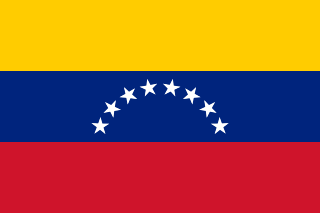
The current national flag of Venezuela was introduced in 2006. The basic design includes a horizontal tricolour of yellow, blue, and red, dating to the original flag introduced in 1811, in the Venezuelan War of Independence.

The coat of arms of Chile dates from 1834 and was designed by the English artist Charles Wood Taylor (1792–1856). It is made up by a figurative background divided in two equal parts: the top one is blue and the bottom, red. A five pointed white star is in the centre of the shield. This background is supported in one side by an Andean condor, the most significant bird of prey from the Andes, and in the other, by a huemul, a mammal endemic to Chile. Both animals wear golden naval crowns symbolising the heroic deeds of the Chilean Navy in the Pacific Ocean.
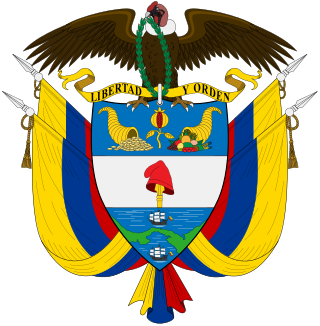
The coat of arms of Colombia contains a shield with numerous symbols. Perched on top of the shield is an Andean condor holding an olive crown and the condor symbolizing freedom. The national motto, Libertad y Orden, is on a scroll in between the bird and the shield in black font over golden background. The condor is depicted as displayed and looking to the right.

The Congress of Angostura was convened by Simón Bolívar and took place in Angostura during the wars of independence of Colombia and Venezuela, culminating in the proclamation of the Republic of Colombia. It met from February 15, 1819, established the new independent-from-Spain nation on December 17, was interrupted by further independentist activity, and reconvened on July 31, 1821, when the Congress of Cúcuta began its sessions. The Angostura assembly consisted of twenty-six delegates representing Venezuela and New Granada.
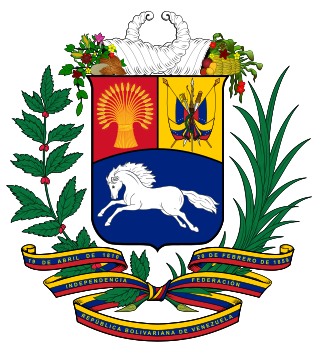
The current coat of arms of Venezuela was primarily approved by the Congress on April 18, 1836, undergoing small modifications through history, reaching the present version.

The coat of arms of the King of Spain is the heraldic symbol representing the monarch of Spain. The current version of the monarch's coat of arms was adopted in 2014 but is of much older origin. The arms marshal the arms of the former monarchs of Castile, León, Aragon, and Navarre.
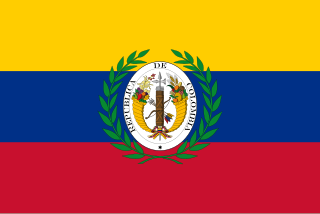
The flag of Gran Colombia was based on Francisco de Miranda's Venezuelan tricolour which served as the national flag of the First Republic of Venezuela, It was served as the basis for the current flags of Colombia, Ecuador, and Venezuela, which emerged as independent nations at the breakup of Gran Colombia in 1831.
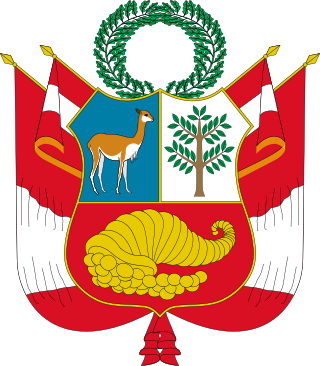
The coat of arms of Peru is the national symbolic emblem of Peru. Four variants are used: the coat of arms per se, the National Coat of Arms, the Great Seal of the State, and the Naval Coat of Arms.
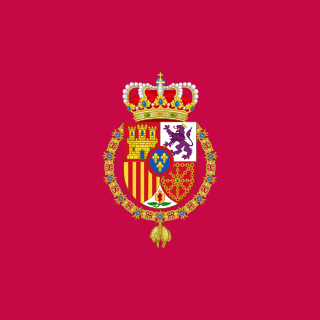
The Royal Standard of Spain is the official flag of the King of Spain. It comprises a crimson square, traditional colour of both Castilian and Spanish monarchs, with the coat of arms of the King in the center. It is raised over the official royal residence in Madrid, the Palacio de la Zarzuela and other Spanish royal sites, when the monarch is in residence and displayed on his official car as small flag. The current flag was adopted when Felipe VI acceded the throne as King of Spain on 19 June 2014. The Royal Standard is regulated by Rule 2 of Royal Decree 527/2014, 20 June, an amendment to Title II of Spanish Royal Decree 1511/1977 adopting Flags, Standards, Guidons, Insignia and Emblems Regulation.

The coat of arms of Ecuador in its current form was established in 1900 based on an older version of 1845.

The Congress of Cúcuta was a constituent assembly where the Republic of Colombia was created. The Congress elected Simón Bolívar and Francisco de Paula Santander president and vice-president, respectively.

The coat of arms of Antioquia, in its current form, dates back to August 23, 1812, when it was officially adopted by the Chamber of the Senate of Antioquia by means of Decree 21 of 1812, replacing the Great State Seal of Antioquia that was sanctioned by State President José María Montoya Duque on September 2, 1811. Following the incorporation of Antioquia to the United Provinces of New Granada and subsequently to the Granadine Confederation and the United States of Colombia, the Sovereign State of Antioquia adopted the coat of arms of Colombia as its state arms. Antioquia reverted to the original coat of arms in 1912 for the occasion of the centenary of the independence of Antioquia and it has been in official use ever since.

Gran Colombia, also known as Greater Colombia and officially the Republic of Colombia, was a state that encompassed much of northern South America and part of southern North America from 1819 to 1831. It included present-day Colombia, mainland Ecuador, Panama, and Venezuela, along with parts of northern Peru, northwestern Brazil, and claimed the Essequibo region. The terms Gran Colombia and Greater Colombia are used historiographically to distinguish it from the current Republic of Colombia, which is also the official name of the former state.

The national flag of Mexico is a vertical tricolor of green, white, and red with the national coat of arms charged in the center of the white stripe. While the meaning of the colors has changed over time, these three colors were adopted by Mexico following independence from Spain during the country's War of Independence, and subsequent First Mexican Empire.

The current coat of arms of Guatemala was adopted after the 1871 Liberal Revolution by a decree of president Miguel García Granados. It consists of multiple symbols representing liberty and sovereignty on a bleu celeste shield. According to government specifications, the coat of arms should be depicted without the shield only when on the flag, but the version lacking the shield is often used counter to these regulations.

The coat of arms of Castile was the heraldic emblem of its monarchs. Historian Michel Pastoureau says that the original purpose of heraldic emblems and seals was to facilitate the exercise of power and the identification of the ruler, due to what they offered for achieving these aims. These symbols were associated with the kingdom, and eventually also represented the intangible nature of the national sentiment or sense of belonging to a territory.






















